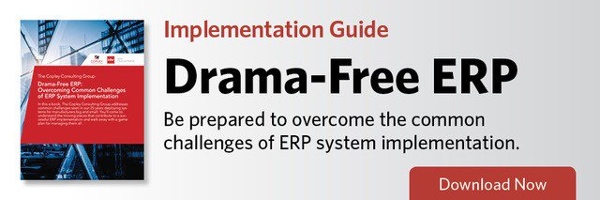In this special blog series, we’ll be discussing common challenges we’ve seen in our 25 years deploying ERP systems for manufacturers big and small. Over the next few weeks, you’ll come to understand the moving pieces that contribute to a successful implementation and walk away with a game plan for managing them all.
ERP implementation requires a tremendous amount of organized action from everyone involved. And as any project manager will tell you, the success of one task is often dependent on the success of another.
While no one likes to walk into a project of this scale with a negative outlook, it doesn’t hurt to remember the mantra “Expect the best, plan for the worst” when planning your deployment. Temper your best-case scenario with a dash of caution with these tried-and-true approaches to defining your budget, schedule and scope.
Budget
There is no denying that ERP systems are a substantial investment. The number you finally settle on – and get approved – for your budget will be one that sticks in the minds of your stakeholders. That’s why when it comes to budgetary planning, your focus should be on the total cost of the project. The individual line items will likely be glazed over by those at the top, so build in needed slack where you can. Although your goal is budget approval, resist the urge to underestimate costs and overstate benefits. And be conservative in your promises related to return on investment. If your project-funding request is denied and you need to downgrade your budget, make sure you reset project expectations as well. This is no time for assumptions; project scope and objectives made need to explicitly change in order to accommodate economy.
Schedule
No one likes to miss a deadline, but all too often ERP project managers find themselves in a position of cutting corners to achieve a go-live date that was unrealistic to begin with. How can this be avoided? The core project management team should sketch out a detailed schedule – and then, before it’s finalized, share that schedule with those who will be executing it. This is an oft-overlooked reality check. Not only will this help to proactively recognize missing tasks and time gaps, but it will ensure you have buy-in prior to project kick-off. A team who has helped develop and approve the schedule will feel much more driven to stick to it when the going gets tough.
Scope
When it comes to blowing budget or schedule, one of the most common culprits is scope creep. Fortunately, there are steps you can take to prevent and mitigate future changes to project scope. It is important to fully assess and vet your scope document out of the gate: follow each point downstream to anticipate required resources, contingencies and challenges, and adjust as needed. Consider working with a deployment plan pre-packaged by your implementation partner that has been built on standard methods and best practices. If you do move forward with a customized scope document, be wary of making changes once you are mid-project. Once a single change is accommodated, political pressures could increase, making it difficult to say no to others and opening the door for project derailment. Audit your scope document early and keep pace with your milestones so you can stay focused on agreed upon objectives rather than introducing new ones.
Conclusion
Replacing your organization’s core operational software involves a lot of moving parts and many variables you can’t completely control. What you can control is how you plan for and manage the inevitable moments of chaos. Make room in the schedule and budget for contingencies. Define a solid and realistic scope. And by all means, stick to your guns. Only with a commitment to firm project management standards can your ERP team stay on task, on time and on budget.

